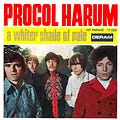In 1967, Procol Harum released one of the few singles to sell 10 million copies worldwide: “A Whiter Shade of Pale.” The members who recorded the No. 5 hit — Gary Brooker (vocals and piano), Matthew Fisher (Hammond M-102 organ), David Knights (bass), Ray Royer (guitar), and session drummer Bill Eyden (later replaced by Bobby Harrison) — had an important “sixth member”: lyricist Keith Reid.
“I had the phrase ‘a whiter shade of pale,’ that was the start, and I knew it was a song,” Reid said in Uncut. “It’s like a jigsaw where you’ve got one piece, then you make up all the others to fit in. I was trying to conjure a mood as much as tell a straightforward, girl-leaves-boy story. With the ceiling flying away and the room humming harder, I wanted to paint an image of a scene.”
“I was at a party in a crowded room and that line came through the air. I saw it in the air and dragged it down,” Reid told Shine On. “The songwriting process is a funny process, it’s like making a pot. You get your initial idea, here I had that line ‘a whiter shade of pale,’ so you’ve got your bit of clay, and then you just try to make a pot out of it. And you use your imagination, you shape it and play with it, until you’ve got something that looks like a pot, or sounds like a song.”
The melody of “A Whiter Shade of Pale” was composed by Brooker and Fisher. “I had been listening to a lot of classical music, and I got particularly keen on what I call baroque music, that might have included Handel and Bach,” Fisher explained in Songwriter Universe. “I also liked the Swingle Singers, who were doing treatments of Bach. They did a fine job on them, particularly the slower songs. It was wonderful.
“Also about that time, the Jacques Loussier Trio — which had a pianist, bass player, and drummer — they made an album called Play Bach. They were a jazz trio, and they’d start off with a piece of Bach, and they would improvise around it.
“Loussier had done a fabulous version of what was called “Air On A G String” which was also used in a set of good adverts in Britain. And all those things came together one morning . . . a bit of Bach and “Air On A G String” going through my head.
“The postman came, and there were some new lyrics from Keith Reid. I opened it up and looked at the first one . . . it was the longest set of words I’d seen from him. I think it was four long verses, and it had these choruses at the end of each lyrical verse. And so I sang them over my idea, and that became the tune, along with the instrumental passages I played in between.”
Like the Left Banke’s “Walk Away Renée” and the Beatles’ “Eleanor Rigby,” “A Whiter Shade of Pale” was called baroque rock. Fisher told Ken Bruce that he weaved Bach’s church cantata “Sleepers Awake” into the song.
“That ‘Air On A G String’ bit was pretty well down to Gary; I mean, he came up with that chord sequence and it was very strongly evocative of ‘Air On A G String,’ and for me to try and play any other note than the one I start off on would have been deliberately going against that, which would have been stupid.
“So I went along with it, and then I drifted into this other thing, this ‘Sleepers Awake’ thing, but all the little bits apart from that actually I did. If I say so myself, you can’t really see the join. A lot of people think that there is actually a Bach tune that is like that, but it isn’t. It’s just a couple of bits of Bach and the rest is me.”
“A Whiter Shade of Pale” was recorded in two takes at Olympic Studios in London. There has long been confusion about the meaning of “A Whiter Shade of Pale.” The consensus is that, like most songs, it’s about a man and a woman trying to get together. The song’s nautical references give a sense that the couple is on board a ship. Fisher said the lyrics are a mystery to him as well.
“I don’t know what they mean. It’s never bothered me that I don’t know what they mean. This is what I find rather hard, that, especially in America, people are terribly hung up about lyrics and they’ve got to know what they mean, and they say, ‘I know, I’ve figured out what these lyrics mean.’ “I don’t give a damn what they mean. You know, they sound great . . . that’s all they have to do.”
Frank Mastropolo is the author of the 200 Greatest Rock Songs series and Fillmore East: The Venue That Changed Rock Music Forever.




